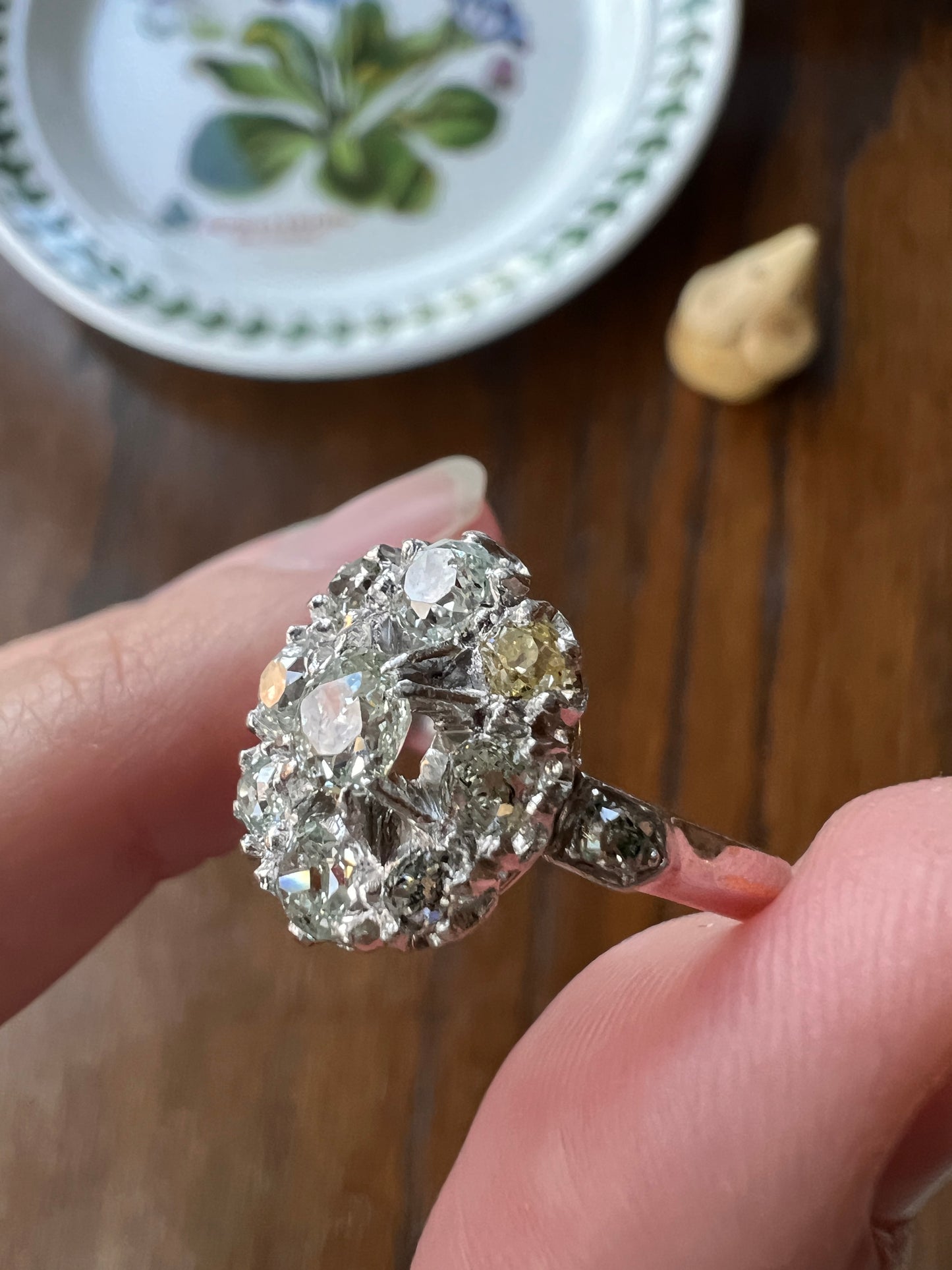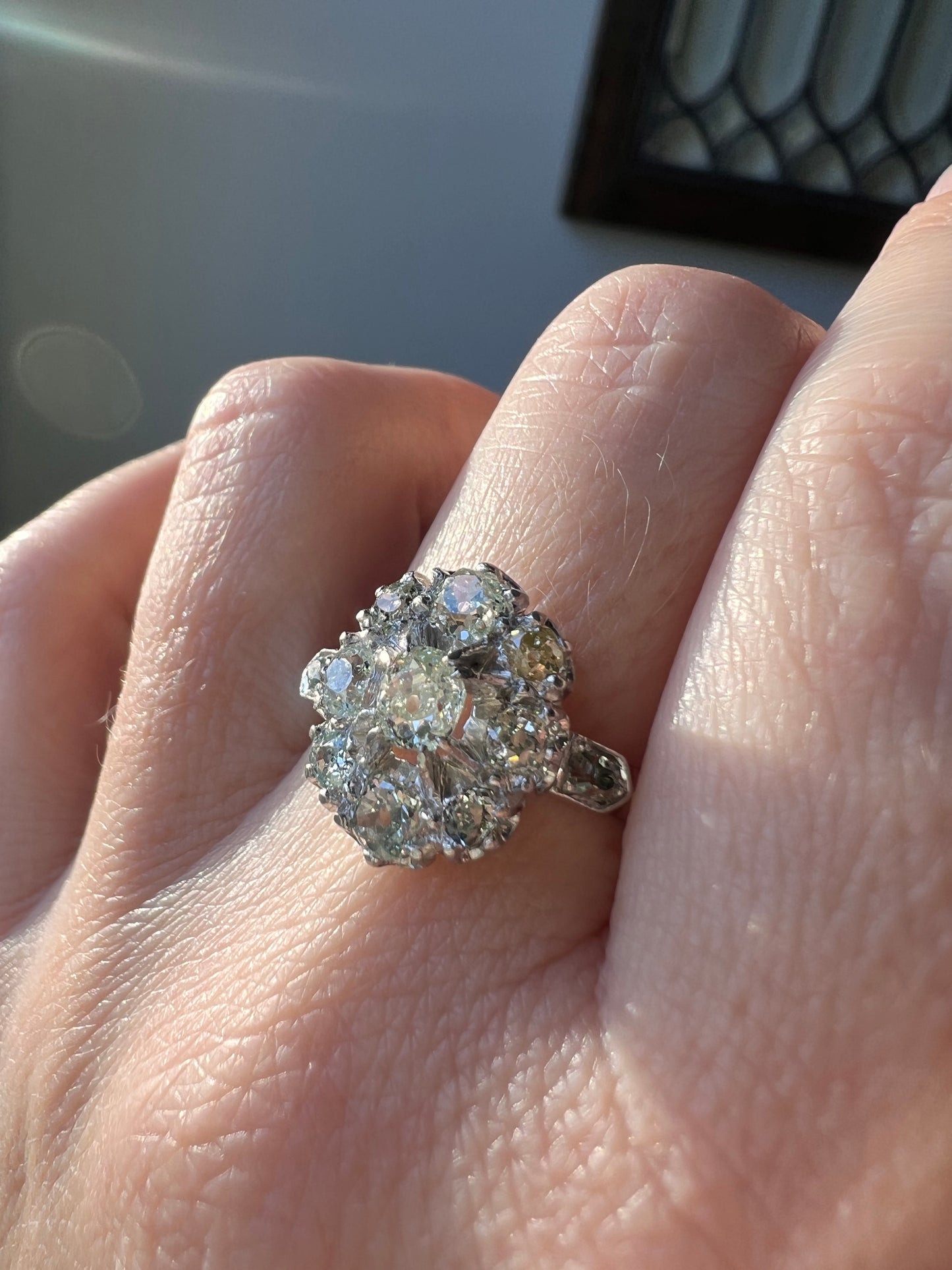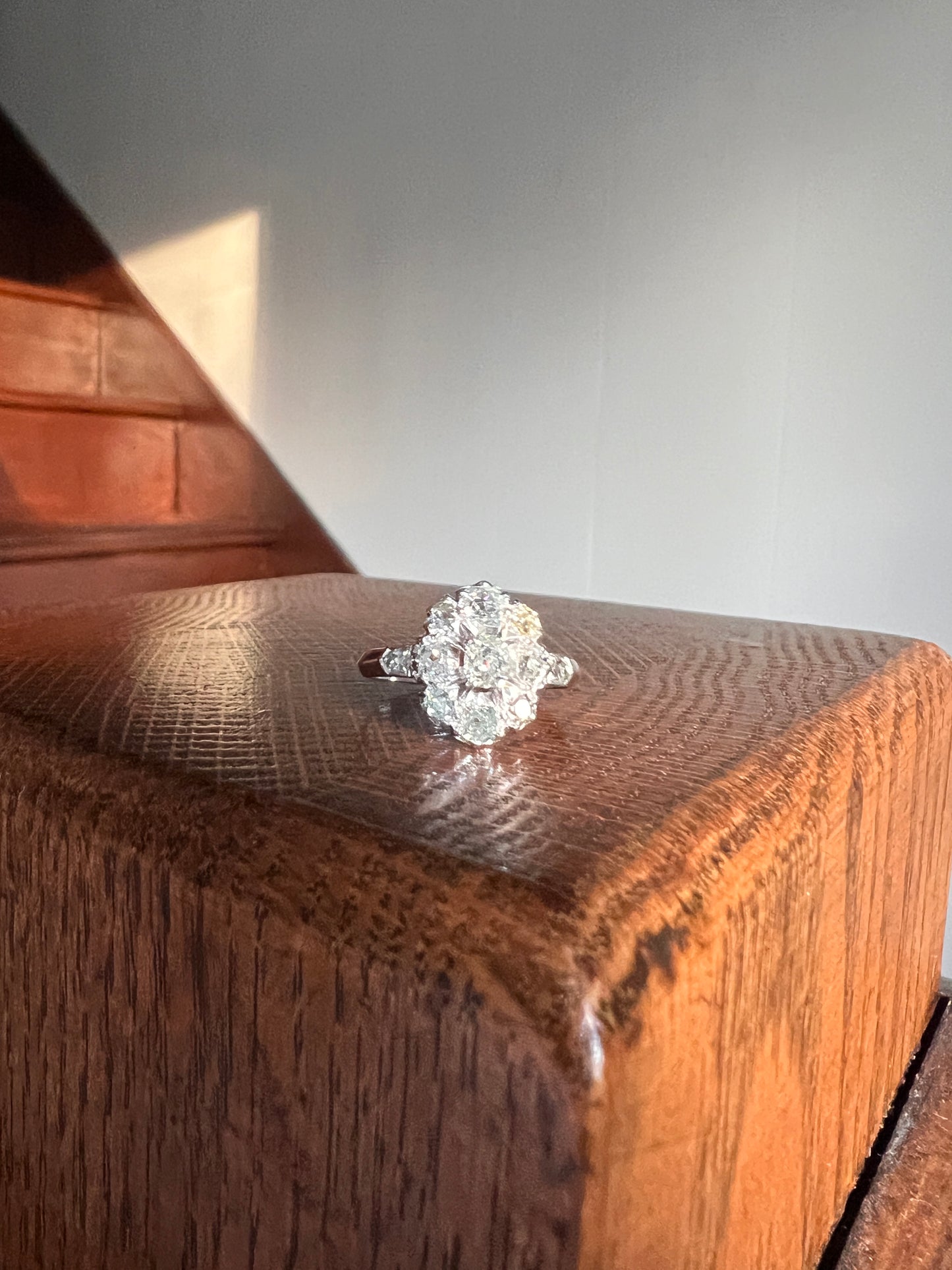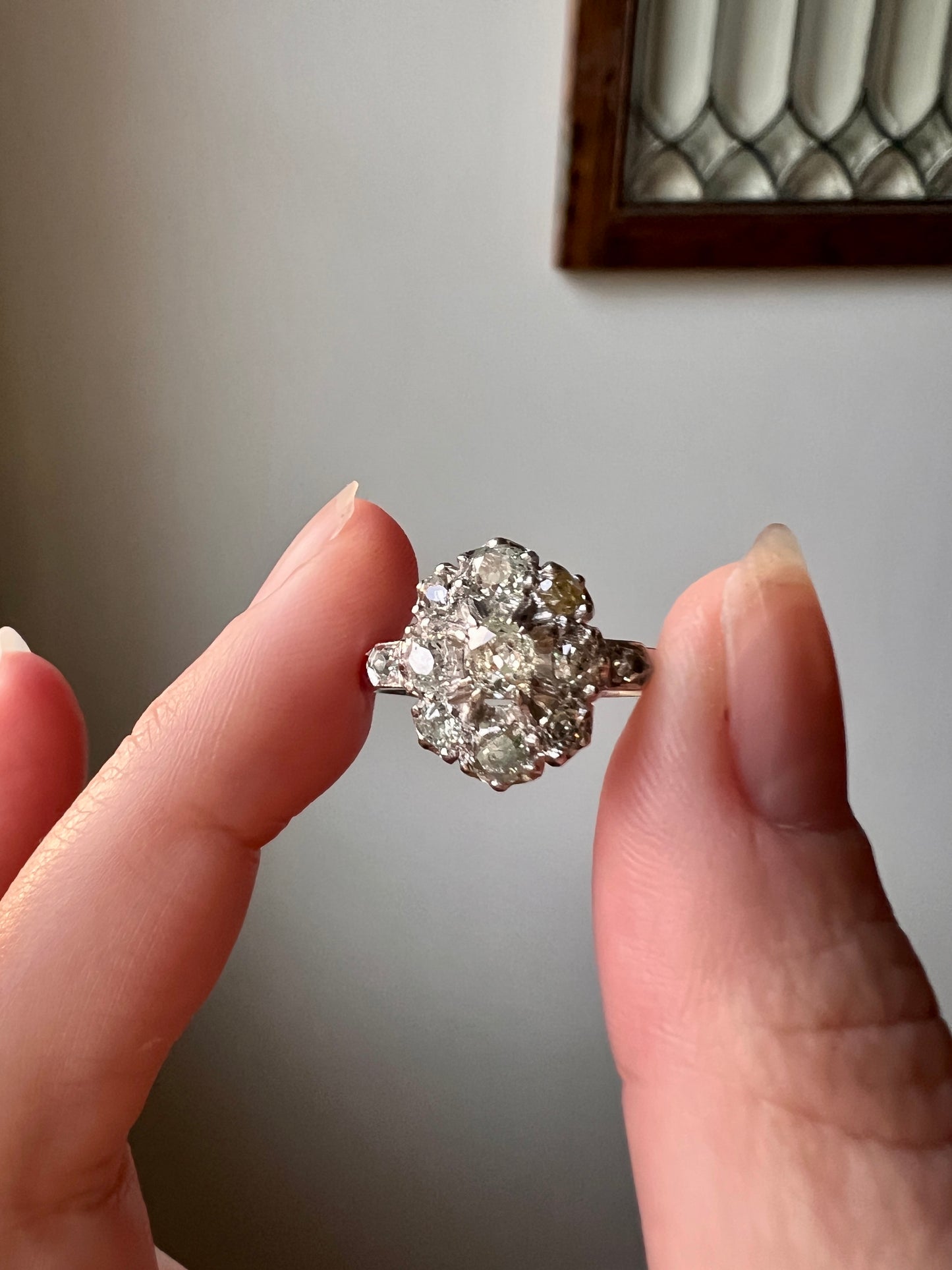Mouse's House Antiques
BLUE Diamonds and YELLOW One of a Kind 1 Carat Old Mine Cut Cluster Ring French ANTIQUE Rhodium 18k Yellow Gold Victorian Gift OmC Ooak Rare
BLUE Diamonds and YELLOW One of a Kind 1 Carat Old Mine Cut Cluster Ring French ANTIQUE Rhodium 18k Yellow Gold Victorian Gift OmC Ooak Rare
Couldn't load pickup availability
ABOUT:
The old mine cut diamond cluster ring always remains among my most popular style of pieces but THIS ONE!
It is even more special due to the hue of these old, natural hand cut stones. Of the cluster, one of the stones is noticeably yellow in color. The others have the palest icy blue hue, almost like a glacier when clean, clear water freezes. I have not seen or had another like it.
Blue diamonds are among the rarest and most valuable on the market. The blue color is caused by the presence of boron in the stone.
Of course all antique hand cut antique diamonds have a more limited supply since they are no longer made in this way. There are only so many in existence compared to the millions of carats of modern machine cut diamonds made every year. These have withstood the test of time.
But then we add in the color - it is believed that only 1 carat in every 10,000 carats mined are colored diamonds, with blues being especially rare. So putting the old hand cut together with the color makes yellow and especially blue OMC pieces even more scarce. Of the 11 diamonds in the ring (including the one at each shoulder), one is yellow, and four have a more noticeable blue hue while the remaining also all have blue hues, but are more subtle. I wonder if the one yellow was chosen intentionally to represent something or if it's just a quirky characteristic? It wasn't uncommon for the period for the goldsmith to use a mix of stones based on what they had available to them.
This ring has even more fun to its story - It is hallmarked with the French mark for 18k gold used primarily in the 1800s - ONLY from 1838 and discontinued completely by 1919. I was stumped at first because white gold as we know was not used prominently in jewelry until about the 1920s, so how could the hallmark be older than the fabrication? Upon studying the ring, I was able to see some underlying yellow gold areas in the shank. So at some point in its history, someone had the ring rhodium plated (this is the vibrant shiny white coating used on most all white gold jewelry from the 1920s onward). So while the piece appears bright and shiny and wears Beautifully as white gold / platinum (unless you study the aforementioned areas of the shank very closely), the piece was actually originally crafted in yellow gold. Just another interesting part of its long story and journey. We often see colored diamonds best portrayed in platinum / white gold settings - so that was likely the intention of the previous owner who had the rhodium plating done over the yellow gold.
A Note For my yellow gold enthusiasts out there, it is "possible" for the rhodium plating to be removed through polishing but that would be something to discuss with your local jeweler as far as cost and their willingness to work on this antique piece. In my opinion, it would be the shank that could be brought back to yellow gold as it is easy to access / polish, whereas the inner workings of the ring face and prongs would be too difficult to get at to effectively polish off the rhodium plating. Having said that, this ring likely originally had silver or platinum prongs anyway, as it was customary for the period to set diamonds in a white precious metal, even when the shank was yellow gold. Of course it is completely and perfectly wearable and amazingly beautiful as is with the vibrant platinum looking rhodium plating. The underlying gold specks in the shank are not really visible with normal wear and seen only with inspection so the piece wears beautifully as is.
So as guaranteed by the legally binding hallmark, this is a French antique piece, from the Victorian Belle Epoque period, crafted in 18k gold.
Versatile and timeless look and certainly one of a kind. And the prongs are really secure making this beauty ready for regular wear which can be difficult to find in antique rings.
Antique box not included. Please note the measurements as I have small hands and it can be difficult to decipher scale from photos.
SIZE & MEASUREMENTS:
The ring is a size 8 1/4 The piece weighs 4.2 grams.
Exact carat weight is unknown as I would not remove the stones but the largest center stone measures 4mm and the ones in the halo are about 2.5 to 3mm each give or take, and 2mm at each shoulder, for around one total carat / 1ctw in diamonds.
Stands 6.8mm off the finger, the ring face is 14mm x11mm. The shank is 2.7mm north south with a knife edge and raised bezels at each shoulder holding the two additional diamonds.
IMPORTANT CONDITION NOTES:
All my pieces are pre-owned and in estate condition. This one is ready for pretty regular wear with most of the prongs in good shape, holding the stones securely.
Typical antique diamonds with some natural inclusions. We especially tend to find more inclusions on diamonds with hues because of how they were formed, so again some of this is typical as color is really the dominant value factor. One of the blues has many darker carbon specks. There are smaller less noticeable carbon specks, a single one here or there, but really all of the stones also have frosty or icy inclusions as well. Some of them carry up to the surface so we see some nicks and uneven facets and frosty spots. As mentioned, the inclusions are often a trade off with antique stones, especially those with hues - I and many other antique jewelry collectors actually enjoy finding these unique characteristics in pieces from the period as opposed to seeking out a high clarity, colorless machine cut stone.
Please do NOTE - The diamonds vary in hue to the eye based on the lighting. In some light and wearing conditions the ring reads a white to gray. The single yellow diamond is most eye noticeable compared to the blue hues, with the pale blue hues becoming most evident in direct sunlight and under lit magnification. But even as I look at it in ambient light now I can still see those beautiful blues. Please view ALL the photos in various lighting conditions and note that in many lights, the blue color is definitely more subtle and may not always jump out at you. Still when studying the stones, the blues are definitely there making these old cuts quite uncommon. And we know any uniqueness is always sought after in antique diamonds.
There are some flakes of loss to the rhodium plating most noticeably at one shoulder at the raised top of the beveled / knife edge shank. This appears as a warm glow in that area where the original yellow gold peeks through.
Shank is very sturdy. But Due to age - please note this is not a mint condition item.
A note about antique diamonds:
The whole "4 C's" of cut, color, clarity, carat didn't come about until the 1940s so prior to that and especially on antique pieces, there was not as much emphasis placed on those things. (Sure people probably appreciated a certain look of a certain diamond as it appeared to the eye but it was not a graded scale like we have today.)
So it is difficult to judge antique stones against modern day diamonds and their grading system. No two old cuts are the same as they were crafted in times lacking any modern standards. The diamond cutters of the time were experts at hand cutting these stones to enhance them. It is also interesting that "lower graded" diamonds in today's scale system, were some of the best on the market during this period!
So it is less about their grades and more about the unique play of light and color that each one can offer. I read one article that put it nicely: “When searching for the perfect old cut diamond (for you), you need to view them through different eyes as you would for a modern diamond, Laboratory grading reports don’t offer too much information in regards to their individual beauty or sparkle which are based more on their individual character and uniqueness that each one potentially offers.” It is also quite common in antique pieces to have varying tints on the same piece as the goldsmiths created pieces with the stones they had available to them. And under magnification on ALL antique cluster rings, you will see differences between the diamonds, their inclusions and hues - each unique to each individual, one of a kind, hand cut stone.
Thanks so much for looking at my items!
Expedited shipping with signature upon delivery will be at my cost.
Box#Mt.!13
Share













































